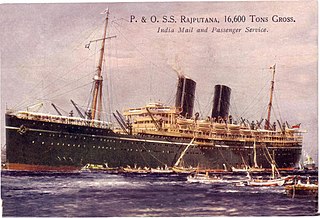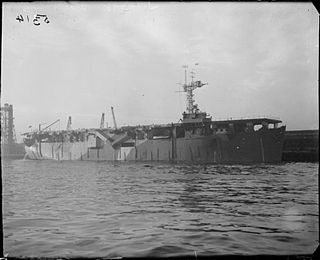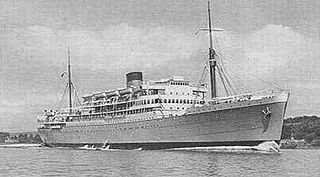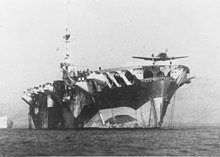
An armed merchantman is a merchant ship equipped with guns, usually for defensive purposes, either by design or after the fact. In the days of sail, piracy and privateers, many merchantmen would be routinely armed, especially those engaging in long distance and high value trade.

HMS Glorious was the second of the three Courageous-class battlecruisers built for the Royal Navy during the First World War. Designed to support the Baltic Project championed by the First Sea Lord, Lord Fisher, they were relatively lightly armed and armoured. Glorious was completed in late 1916 and spent the war patrolling the North Sea. She participated in the Second Battle of Heligoland Bight in November 1917 and was present when the German High Seas Fleet surrendered a year later.

HMS Biter was a Royal Navy escort carrier during the Second World War. She was laid down as a merchant ship at the Sun Shipbuilding & Drydock Company yard at Chester, Pennsylvania. Laid down on 28 December 1939, she was converted to an escort carrier and commissioned in the Royal Navy on 6 May 1942. She was returned to the United States in 1945 and subsequently lent to France.
HMS Audacity was a British escort carrier of the Second World War and the first of her kind to serve in the Royal Navy. She was originally the German merchant ship Hannover, which the British captured in the West Indies in March 1940 and renamed Sinbad, then Empire Audacity. She was converted and commissioned as HMS Empire Audacity, then as HMS Audacity. She was torpedoed and sunk by a German U-boat in late 1941.

HMS Queen Emma was a commando troop ship of the Royal Navy during the Second World War. Built as a civilian passenger liner in 1939 by De Schelde at Vlissingen, she was named the MS Koningin Emma, after Queen Emma of the Netherlands, and operated by Stoomvaart Maatschappij Zeeland (SMZ) between Flushing and Harwich, along with her sister ship, MS Prinses Beatrix. After fleeing to Britain after the German invasion in 1940, she was requisitioned by the British Ministry of War Transport, renamed HMS Queen Emma and converted to a troopship at Harland and Wolff's yard in Belfast. During the war her main role was transporting British Commandos, and she participated in the Lofoten Islands Raid and the Dieppe Raid. She had the advantage of a high speed that allowed hit and run operations. Later designated as a Landing Ship, Infantry (Medium) she took part in the landings in North Africa, Sicily and Normandy. She operated in the Indian Ocean, and in the Dutch East Indies after the end of the war. In 1946 Queen Emma was returned to her owners and continued to operate as ferry from the Hook of Holland until 1969, when she was scrapped in Antwerp, Belgium.

The Hawkins class consisted of five heavy cruisers built for the Royal Navy during the First World War, although none of them saw service during the war. The first ship to be completed, HMS Vindictive, was renamed from HMS Cavendish and converted into an aircraft carrier while under construction. All ships were named after Elizabethan sea captains. The three ships remaining as cruisers in 1939 served in the Second World War, with Effingham being an early war loss through wreck; Raleigh had been lost in a similar shipwreck on uncharted rocks in 1922. Vindictive, though no longer a cruiser, also served throughout the War. This class formed the basis for the definition of the maximum cruiser type under the Washington Naval Treaty of 1922.

HMAS Kanimbla was a passenger ship converted for use as an armed merchant cruiser and landing ship infantry during World War II. Built during the mid-1930s as the passenger liner MV Kanimbla for McIlwraith, McEacharn & Co, the ship operated in Australian waters until 1939, when she was requisitioned for military service, converted into an armed merchant cruiser, and commissioned in the Royal Navy as HMS Kanimbla.

HMS Vindictive was a warship built during the First World War for the Royal Navy (RN). Originally designed as a Hawkins-class heavy cruiser and laid down under the name Cavendish, she was converted into an aircraft carrier while still being built. Renamed in 1918, she was completed a few weeks before the end of the war and saw no active service with the Grand Fleet. The following year she participated in the British campaign in the Baltic against the Bolsheviks, during which her aircraft made numerous attacks against the naval base at Kronstadt. Vindictive returned home at the end of the year and was placed in reserve for several years before her flight decks were removed and she was reconverted back into a cruiser. The ship retained her aircraft hangar and conducted trials with an aircraft catapult before she was sent to the China Station in 1926. A year after her return in 1928, she was again placed in reserve.

HMS Rawalpindi was a British armed merchant cruiser, that was sunk in a surface action against the German battleships Scharnhorst and Gneisenau during the first months of the Second World War. Her captain was Edward Coverley Kennedy.

HMAS Westralia (F95/C61) was an auxiliary cruiser of the Royal Australian Navy (RAN). Built by Scottish shipbuilder Harland and Wolff and completed in 1929, Westralia was operated by the Huddart Parker company until 1939, when she was requisitioned for service with the RAN as an Armed Merchant Cruiser (AMC). Fitted with guns and commissioned in early 1940, Westralia was initially used to escort convoys in the Pacific and Indian oceans. In November 1940, the largest mutiny in RAN history occurred aboard the ship, with 104 men charged.

SS Rajputana was a British passenger and cargo carrying ocean liner. She was built for the Peninsular & Oriental Steam Navigation Company at the Harland and Wolff shipyard at Greenock on the lower River Clyde, Scotland in 1925. She was one of the P&O R-class liners from 1925 that had much of their interiors designed by Lord Inchcape's daughter Elsie Mackay. Named after the Rajputana region of western India, she sailed on a regular route between England and British India.

HMS Vindex (D15) was a Nairana-class escort carrier of the Royal Navy that saw service during the Second World War. She was built at Swan Hunter shipyards in Newcastle upon Tyne. When construction started in 1942 she was intended as a merchant ship, but was completed and launched as an escort carrier, entering service at the end of 1943.

The Nairana-class escort carrier was a British-built class of three escort carriers. They were constructed one each in England, Scotland and Northern Ireland to the same basic design during the Second World War for service with the Royal Navy.
Pretoria Castle may refer to one of the following ships:

HMS Forfar (F30) was a British ocean liner that was commissioned into the Royal Navy as an armed merchant cruiser in 1939 and sunk by enemy action in 1940. She was launched in Scotland in 1920 as a transatlantic liner for the Canadian Pacific Steamship Company as Montrose. She was one of three sister ships. The others were Montcalm, also launched in 1920, and Montclare, launched in 1921.

HMS Artifex was a repair ship of the Royal Navy from late in the Second World War and into the Cold War. Launched as the Cunard liner RMS Aurania she was requisitioned on the outbreak of war to serve as an armed merchant cruiser. Damaged by a U-boat while sailing with an Atlantic convoy, she was purchased outright and converted to a floating workshop, spending the rest of her life as a support ship for the navy.

MV Carnarvon Castle was an ocean liner of the Union-Castle Line. She was requisitioned for service as an auxiliary cruiser by the Royal Navy during the Second World War.
RMS Andes was a 26,689 GRT steam turbine Royal Mail Ship, ocean liner, cruise ship, and the flagship of the Royal Mail Lines fleet. She was the second Royal Mail ship to be named after the South American Andes mountain range. The first RMS Andes was an A-class liner launched in 1913. In 1929 that RMS Andes was converted into a cruise ship and renamed Atlantis.

RMS Asturias was a Royal Mail Lines ocean liner that was built in Belfast in 1925. She served in the Second World War as an armed merchant cruiser until she was crippled by a torpedo in 1943. She was out of action until 1948 when she returned to civilian service as an emigrant ship. She became a troop ship in 1954 and was scrapped in 1957.

HMS Dunvegan Castle was a UK ocean liner that was converted into an armed merchant cruiser (AMC) in the Second World War. Harland and Wolff built her and her sister ship Dunnottar Castle in Belfast in 1936.


















